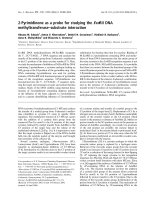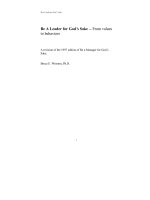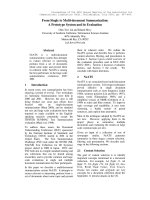Be A Leader for God’s Sake -- From values to behaviors doc
Bạn đang xem bản rút gọn của tài liệu. Xem và tải ngay bản đầy đủ của tài liệu tại đây (539.16 KB, 199 trang )
Be a Leader for God’s Sake
i
Be A Leader for God’s Sake From values
to behaviors
A revision of the 1997 edition of Be a Manager for God’s
Sake.
Bruce E. Winston, Ph.D.
Be a Leader for God’s Sake
ii
© 2002 Bruce E. Winston, Ph.D.
Production and distribution by:
School of Leadership Studies
Regent University
1000 Regent University Drive
Virginia Beach, VA 23464
ISBN 0-9725819-0-1
Single copies of this book may be purchased at
www.amazon.com and selected bookstores.
Orders for 10 or more books may be ordered at a distributor
price from:
School of Leadership Studies
Regent University
1000 Regent University Drive
Virginia Beach, VA 23464
757-226-4306
Content used in this book is also found in the seminar Be a
Leader for God’s Sake
®
presented by Bruce E. Winston,
Ph.D. For more information on the seminar please contact
Bruce Winston at the address above. A four-videotape set of
the seminar Be a Leader for God’s Sake
®
is available as
well.
Be a Leader for God’s Sake
iii
Preface to the Revised Edition
In my early days of teaching in the Regent University School
of Business MBA program, roughly 1994-96, it was difficult
to find books or articles that explained the scriptural base of
leadership, or at least leadership as I saw it represented in the
Scriptures. To answer this need, I began writing essays to
help the MBA students better understand what the Bible has
to say about managing and leading people. In 1998, the
School of Business published a collection of these essays in
a book called Be a Manager for God’s Sake.
Since that first publication, I have transferred to the School
of Leadership Studies at Regent University and have shifted
the focus of my teaching to training leaders in all types of
organizations rather than just training leaders in business.
My new focus on training organizational leaders, in America
and literally around the world (thanks to the Internet), has
brought me to the crossroads of revising my book. This
second edition contains stories from my own experience of
seeking to Be a Leader for God’s Sake. It is my sincere hope
that the message of this book will take you closer to
understanding how you become the leader you were intended
to be, a leader for God’s sake.
This new phase of my own journey has encouraged some re-
thinking on my part. I have come to understand that
leadership is leadership regardless of the type of company
or organization. I won’t be surprised if some folks have a
little trouble with this notion, in fact, in my early days with
the School of Leadership Studies, I had believed that the
leaders of schools, churches, para-church ministries, and
commercial enterprises were all different. But as I continued
to work with these master’s and doctoral students who were
Be a Leader for God’s Sake
iv
leaders from all types of organizations, it became clear that
regardless of the types of situations they were in, they each
faced the same types of problems and challenges.
Amazingly, they all shared the same, basic foundational
values of leadership. Even with the differences between the
various disciplines and cultures, the core terminology, values
and semantics apply.
I have presented numerous seminars based on this content
and participants have aided in the process of proving this
theory. Learning from their astute questions, I could see how
the leader’s foundational values yield beliefs, and how their
beliefs yield intentions to behave, and how from their
intentions spring actual behavior. The leader’s behavior then
helps form the followers’ attitudes
that affect how followers
behave. These steps form the path of this book: (1)
foundational values, (2) how values relate to behaviors, (3)
how leaders interact with the organization, and (4) how
followers interact with leaders. Since it is impossible to
completely separate each of these elements, the chapters of
this book include each of the four elements.
During this time of my own journey through the process of
internalizing the values of the Beatitudes, I read the book
Flight of the Buffalo by James Belasco, and I identified with
his imagery of the leader who saw himself as a buffalo that
wanted to transform himself into an eagle and soar above the
earth.
As the buffalo worked at transforming himself, he would
achieve the state of the eagle from time to time only to find
that while he was an eagle, he would revert to his buffalo
values and tactics and turn back into a buffalo and crash to
the ground. I described this book to my staff and committed
myself to continue to work on the transformation, and asked
Be a Leader for God’s Sake
v
the employees who worked with me, if they would also
commit to reminding me when I became the buffalo again.
Note to the fourth printing:
My thanks to Jane Waddell for her proofreading and
suggested edits to the book. The product is better now
because of her efforts.
Be a Leader for God’s Sake
vi
Be a Leader for God’s Sake
vii
Dedication
I am indebted to the many students and seminar attendees
who have tested my understanding of these concepts and
who have helped me shape my understanding through our
many dialogues. I am also grateful to Julia Matera and Kerry
Park who read and edited this current edition. I want to
recognize the contribution of Julianne Robbins Cenac who
helped me work through the original essays on the Fruit of
the Spirit and Proverbs 31.
I am especially grateful to my wife and friend Kristie who
has traveled many miles with me on numerous seminars
setting up equipment, handing out materials, and helping me
see what content areas the audience might like more
information about.
Bruce E. Winston, Ph.D.
Be a Leader for God’s Sake
viii
Be a Leader for God’s Sake
ix
Table of Contents
DEDICATION VII
TABLE OF CONTENTS IX
INTRODUCTION 1
CHAPTER 1: LEADERSHIP IS FIRST OF ALL - LOVE! 4
CHAPTER 2: THE VALUE OF BEING POOR IN SPIRIT 20
CHAPTER 3: THE VALUE OF CARING FOR
EMPLOYEES/FOLLOWERS 28
CHAPTER 4: THE VALUE OF CONTROLLED
DISCIPLINE 41
CHAPTER 5: THE VALUE OF ALWAYS SEEKING
WHAT IS RIGHT 54
CHAPTER 6: THE VALUE OF MERCY IN A WORLD
THAT SEEMS TO LACK MERCY 63
CHAPTER 7: THE VALUE OF INTEGRITY AND
A FOCUSED PURPOSE 72
CHAPTER 8: THE VALUE OF MAKING AND
KEEPING PEACE 81
CHAPTER 9: SUMMARIZING THE BEATITUDES AND
PREPARING FOR THE NEXT SECTION 89
CHAPTER 10: APPLICATIONS FROM THE
MOUNTAINTOP 92
CHAPTER 11: HARVESTING THE FRUIT OF
AGAPAO LEADERSHIP 134
Be a Leader for God’s Sake
x
CHAPTER 12: LEADERSHIP ACCORDING
TO PROVERBS 31 150
CHAPTER 13: LEADERSHIP AND THE ROMANS 12
SPIRITUAL GIFTS 164
CHAPTER 14: JUST LEADERSHIP – NOT FAIR
LEADERSHIP 179
CONCLUSION: HOW’S YOUR LEADERSHIP? 185
REFERENCES 186
Be a Leader for God’s Sake
1
Introduction
At last count, there were over 10,000 articles and books on
leadership that have emerged in the last few years. A recent
query at www.amazon.com on the word leadership produced
8,616 hits. So why write another book on leadership? What
is it about this book that is different? The answer lies in the
simplicity of leadership itself that leadership starts with
values. Many of the books currently on the market attempt to
define the behaviors of leaders, or at least in the minds of the
authors, the most important behaviors. Leaders read the
material and attempt to practice the behaviors usually with
mixed results. My approach focuses first on the values of
leadership as described in The Beatitudes found in Matthew
5:3-11, and then proceeds to discuss the behaviors that
follow The Beatitudes (Matthew 5:13 - 7:27).
To help the reader use this information, I have included short
pause and reflect sections throughout this edition. These
pause and reflect points are the same as what the psalmist
meant with the word Selah found in many of the songs and
poems in the Book of Psalms.
The first premise of this book is that values have to be based
on something, and that “something” for this book, is agapao
love as presented in the first chapter. This concept supports
my theory that leadership begins with this overarching value
of love that forms the foundation for the other lesser values.
The second premise of this book is that human leaders are
just human! We are not perfect, and most of us, myself
included, fail in our efforts to live the life of a perfect leader.
A key to preventing followers from becoming disenchanted
with their leader(s) is for the leader to admit a lack of
perfection, and to do so frequently! Followers can be very
Be a Leader for God’s Sake
2
forgiving if they see their leader(s) admitting faults and
continually trying to improve.
As you read this book, take time at the Selah sections and
make some notes to yourself about what values you need to
work on. If you are comfortable that you have your values in
place, then start by thinking about the behaviors that emerge
from the values. Spend some time with a few followers who
are willing to tell you the truth as they see you! Good leaders
are accountable to their followers, and this accountability is
one of the traits of leaders who follow the concepts laid out
in this book.
Every author brings his or her biases and beliefs to the
manuscript, and I offer mine up front. I am not a biblical
scholar, so I am grateful for the opportunity to work at
Regent University where we do have biblical scholars who
have reviewed my work at various stages of the manuscript. I
am a leader who approaches Scripture-seeking in order to
understand how the words recorded so long ago, apply to
today’s world of organizations and leaders. For many of us,
the situations presented in the Old and New Testaments are
difficult to comprehend since there is little direct relation to
situations today. For example, salt was a precious and rare
element to the Hebrews living in Israel at the time of the
Sermon on the Mount. Today, however, we have plenty of
salt, so much in fact that we take it for granted. These
differences alone would be enough to complicate our
understanding of Scripture, but we also face the challenge of
the translation of the Word from the original Greek into
English. While English is a wonderful language and
thankfully for us in the United States, it is a commonly used
language around the world it is not a good language to use
for translating Biblical Greek. Biblical Greek is a very
Be a Leader for God’s Sake
3
precise language with many different words that have subtle
and not so subtle differences in meaning. In the chapters that
follow, I will include comments that may help you
understand the use of certain examples that were important
to the people for whom Scripture was first written, and how
the Greek was first applied in their lives.
As we proceed, get ready to be wonderfully surprised at just
how much God’s Word has to say about today’s
organizations, and more specifically, about today’s leaders!
If what I learned has changed my leadership skills, you can
be sure that there is something in this book that will impact
your life for good!
Be a Leader for God’s Sake
4
Chapter 1: Leadership is First of All - Love!
In my early days of teaching, I used to theorize that if the
Bible applied to our daily life, then it must also apply to our
work life. This may not seem like a big leap to most people,
but I was an assistant professor in a graduate school that was
teaching students a Christian-based approach to business. In
most instances, I thought I was doing a pretty good job. I
used Scripture to teach about marketing ethics, stewardship,
salaries and other basic business themes. But I didn’t know
just how much deeper I could go in the understanding of how
Scripture applied to our professions. I knew that many
leaders and many of my students used the Bible on Sunday,
but on Monday the Book went back onto the shelf to sit idly
by for the next six days.
Nearly everyone is familiar with the verse, “Love your
neighbor as you love yourself” Matthew 19:19, but at work,
who is my neighbor? Can, or should, a leader love his or her
followers? What does it mean to love?
I knew of three Greek words for love: eros, phileo, and
agape. The first type of love, eros, is sexual love, so this
obviously could not apply. Leaders who approach followers
with this form of love end up with lawsuits or jail sentences,
and rightfully so.
Could it be the second type of love, phileo the “brotherly
love”? As an only child, my understanding of this type of
love comes from watching the interaction between my three
sons growing up together. While my sons, at times, were as
supportive to each other as the Three Musketeers, there were
also times of divisiveness. While some aspects of this
brotherly love seemed appropriate, not all of it seemed to
apply.
Be a Leader for God’s Sake
5
The third type of love, agape, is a self-sacrificing love that
references total commitment even unto death. If an employee
needed a kidney transplant would I give a kidney – what if
the employee needed a heart transplant? I found myself lost
in how to apply these three forms of love to leadership in the
workplace.
Persistent, and more than just a little desperate, I sought the
Greek text more closely and, indeed, found a fourth type of
love agapao love. This Greek word refers to a moral love,
doing the right thing at the right time for the right reason.
More specifically, agapao means to love in a social or moral
sense, embracing the judgment and the deliberate assent of
the will as a matter of principle, duty, and propriety. Now I
was getting somewhere. This seemed like something that
made sense for a leader. I examined the usage of agape and
agapao in the New Testament and while agape seemed to
refer to God’s love for us or for Jesus’ love for the Father,
agapao seemed to refer to people loving one another. I have
since found the word agapao in other writers’ works, but
usually the other writers miss a key point by combining the
two words agapao and agape treating them the same when
the meanings are quite different. The need to fully appreciate
this kind of “love” in the workplace deserves some thought
on our part. The English language uses this single word love
for all types of love. Added to that, American society
constantly changes the nuances of the word. For instances, in
the 1960s, we “loved” everyone and everything at least in
words if not in deeds. There is a need for greater specificity
in meaning, which brings me back to the use of agapao.
Here are a few of the Scriptures in the Gospels that use the
word agapao. As you read these references, note the action
and behavior.
Be a Leader for God’s Sake
6
Scriptures from the Gospels using the Greek
Agapao
“But I tell you: Love your enemies and pray for those
who persecute you, . . .”
Matthew 5:44
“If you love those who love you, what reward will you
get? Are not even the tax collectors doing that?”
Matthew 5:46
“No one can serve two masters. Either he will hate the
one and love the other, or he will be devoted to the one
and despise the other. You cannot serve both God and
Money.”
Matthew 6:24
“‘ . . . honor your father and mother,’ and ‘love your
neighbor as yourself.’”
Matthew 19:19
“Love the Lord your God with all your heart and with
all your soul and with all your mind and with all your
strength.”
Mark 12:30
“The second is this: ‘Love your neighbor as yourself.’
There is no commandment greater than these.”
Mark 12:31
“To love him with all your heart, with all your
understanding and with all your strength, and to love
your neighbor as yourself is more important than all
burnt offerings and sacrifices.”
Be a Leader for God’s Sake
7
Mark 12:33
“But I tell you who hear me: Love your enemies, do
good to those who hate you, . . .”
Luke 6:27
“If you love
those who love you, what credit is that to
you? Even ‘sinners’ love
those who love them.”
Luke 6:32
“But love your enemies, do good to them, and lend to
them without expecting to get anything back. Then your
reward will be great, and you will be sons of the Most
High, because he is kind to the ungrateful and wicked.”
Luke 6:35
“No servant can serve two masters. Either he will hate
the one and love the other, or he will be devoted to the
one and despise the other. You cannot serve both God
and Money.”
Luke 16:13
“Jesus said to them, ‘If God were your Father, you
would love me, for I came from God and now am here. I
have not come on my own; but he sent me.’”
John 8:42
“So the sisters sent word to Jesus, ‘Lord, the one you
love
is sick.’”
John 11:3
Be a Leader for God’s Sake
8
“A new command I give you: Love one another. As I
have loved you, so you must love one another.”
John 13:34
“If you love me, you will obey what I command.”
John 14:15
“Whoever has my commands and obeys them, he is the
one who loves me. He who loves me will be loved by my
Father, and I too will love him and show myself to him.”
John 14:21
“Jesus replied, ‘If anyone loves me, he will obey my
teaching. My Father will love him, and we will come to
him and make our home with him.’”
John 14:23
“He who does not love me will not obey my teaching.
These words you hear are not my own; they belong to
the Father who sent me.”
John 14:24
“ . . . but the world must learn that I love the Father and
that I do exactly what my Father has commanded me.
‘Come now; let us leave.’”
John 14:31
Agapao love is alive and well today and may be best
understood in light of the Golden Rule: “Do unto others as
you would have them do unto to you,” and even more to the
Platinum Rule of “Do unto others as they want you to do
unto them.” Agapao, as a moral love, means that today’s
leaders must consider the human and spiritual aspects of
their employees/followers. The people working for you are
Be a Leader for God’s Sake
9
not just flesh and blood who respond to wages as a mule
responds to a carrot on a stick. Your employees are complete
people with physical, mental, and spiritual needs.
Employees today do not see the employer through the same
loyalty-shaded glasses, as did the employees of the 1950s.
Rather, there is a much greater sense from employees that
they stay with an employer because it is mutually beneficial
on several levels: in physical terms, such as compensation; in
mental terms, such as in a stimulating relationship; and in
spiritual terms, such that the greater “self” is served and
blessed by the involvement with the leader. This is the basis
for love (agapao), to consider each employee/follower as a
total person with needs, wants, and desires. Employees want
to be considered for their brains and their hearts as well as
their hands. The call of agapao love in the organization is to
go far beyond seeing people as “hired hands,” to seeing
them as “hired hearts.”
You may be surprised to find that God calls leaders to love
more than their employees. Employees and followers want
leaders who are honest, open, and who keep the organization
moving in a positive direction during both calm and stormy
seas. Employees and followers want leaders who are
“others-centered.” Employees and followers want leaders
who can bring out the best qualities in them. This requires
leadership agapao leadership! Beyond this, leaders must
also love all the organization’s stakeholders from customers,
vendors, regulators, shareholders, members, as well as
contributors.
In his book, Leadership Jazz, Max Depree provides a
wonderful and colorful description of the
employer/employee exchanges that happen in servant
Be a Leader for God’s Sake
10
leadership. I believe his metaphor also applies to agapao
leadership.
“A Jazz band is an expression of servant leadership.
The leader of a jazz band has the beautiful
opportunity to draw the best out of the other
musicians. We have much to learn from jazz-band
leaders. For jazz, like leadership, combines the
unpredictability of the future with the gifts of
individuals” (p. 9).
Depree is saying that you must love someone so much that,
within the framework of employment, you care enough to
learn the gifts of the individual and draw out from them what
is good and what fits the needs of the organization. This
focus puts the emphasis on the employee first followed by
learning what the individual’s “best” talents are, and then
seeking how to apply this to the organization. People who
engage their gifts and work in the areas of their abilities are
happier and more productive. The simplicity of this is
obvious when you consider that employees who are happy
produce more and with less effort. The end result is better for
the organization. However, the agapao leader must not see
the employee as just a benefit to the organization, but must
also see the reciprocal benefit to the employee.
The paradox of an agapao form of leadership, compared to
an economic form of leadership, is that while the agapao
leader concentrates less on the organization and more on
individuals the organization gains more because the
employees are working to uphold the organization’s needs.
Here’s a personal example of this relationship in action.
Some of the employees with whom I work have young
children. From time to time, an employee’s child will get
Be a Leader for God’s Sake
11
sick or need additional care that results in the employee
missing work. From an economic view of leadership, it
doesn’t make sense to encourage parents, moms or dads, to
stay home and provide the extra childcare needed. But, in an
agapao form of leadership, we encourage the employee to
stay home. My experience so far, is that every employee who
has an agapao view of the leader-follower relationship has
accomplished more work, even with the occasional days
spent at home. How does this happen? It’s simple. The
employee arranges to take work home with them or arranges
for the spouse to pick up materials on his or her way home in
the evening, or the employee takes work home over the next
couple of days, or comes in on the weekend to accomplish
the needed tasks. Agapao behavior is a relationship and the
behavior is reciprocal. Also, since the employee knows that
the agapao leader has the employee’s best interest at heart,
the employee is willing to go the extra mile for the leader.
“Every great man is always being helped by
everybody; for his gift is to get good out of all
things and all persons.”
John Ruskin
Although there are short-term elements of the leader-
follower relationship, such as financial compensation, for the
agapao leadership paradigm to be successful, the paradigm
should be viewed as a long-term condition.
How did we become so unloving?
Taylor’s scientific leadership concepts, that so many of us
have practiced over the years, focuses on the pay part of the
leader-employee relationship. In and of itself, there is
nothing wrong with this. In the early 1900s, Taylor saw the
poor conditions in which his employees lived and he longed
Be a Leader for God’s Sake
12
to do something about it. He knew that he could not just give
a raise to every worker since this violated his stewardship
obligation to the owners of the steel mill where he worked
(Weisbord, 1991).
Taylor knew that if he developed a better way for employees
to produce more for the company, he could pass some of the
increased reward to the employees. He was successful, and
his employees earned more pay that led to better living
conditions for the workers’ families. Taylor clearly desired
to meet the physical needs of his employees. However,
Taylor fell short in two areas as he ignored the emotional
and spiritual needs of the employees.
In the 1930s, the human behavior school of thought
promulgated by Mayo, McGregor, and Argyris, among
others, emphasized the emotional and social side of
employees. These theories led to a phileo love where leaders
strove to meet the emotional needs of the employee.
The human resource school of thought followed the human
behavior school of thought and taught leaders to treat people
as bearers of skills and abilities. This concept advocates the
hiring of the whole person, not just a jobholder. This
progression brought us closer to treating the employee as a
whole person body, mind, and soul, and this is the state to
which DePree referred.
Unfortunately, not all leaders followed the progression from
the scientific school to the human resource school. It seems
that for many leaders, the scientific school was the last
classroom that they attended. Of course, this is reasonable
since the main focus of the commercial enterprise
community has been on Adam Smith’s concepts of self-love
Be a Leader for God’s Sake
13
as stated in his 1776 document, The Wealth of Nations.
Smith wrote:
It is not from the benevolence of the butcher, the
brewer, or the baker that we expect our dinner,
but from their regard to their own interest. We
address ourselves, not to their humanity but to
their self-love, and never talk to them of our own
necessities but of their advantages.
In Smith’s opinion, no one does anything except for what’s
in it for self. Unfortunately, our foundational concepts
regarding commercial endeavors are based on Smith’s
writings. It is not surprising that we see so much self-love in
our commercial enterprises and so little agapao love. A more
thorough reading of Smith’s Wealth of Nations reveals many
other values and beliefs that have shaped our leader-follower
values and relationships. For now, consider how Smith’s
statement creates a value of mistrust and caution when
engaging other people. If suppliers are only interested in
their own benefit, then it is logical that employees and
leaders are also only interested in their own self-interests and
that they will only engage in activities that are personally
profitable. What a marked contrast to agapao leadership.
Another layer to the leader-follower relationship was created
by the concept of functional supervision, a characteristic of
the scientific school. This concept suggests that foremen in a
company must be specialists in an area of a company’s
operation in order to lead the workers. Functional superiority
led supervisors to believe that they were better than the
workers and that workers should not think, but rather do
what the supervisor required. While it is true that the
functional foreman did know more about the subject matter,
it did not imply that the foreman was better than the worker
Be a Leader for God’s Sake
14
or that the worker should not think independently. Rather,
the foreman became a repository of information available to
others.
A similar scenario occurred with the administrative duties
that supervisors once performed. In order to allow the
supervisors to have more time to become functionally
proficient, Taylor’s approach to leadership removed the
functions of record keeping, payroll, etc., and assigned these
administrative functions to separate departments. Soon, the
supervisors found people in support departments acting like
they were better than the supervisors an interesting process
of values, to beliefs, to attitudes, to behaviors! The values
defined in The Beatitudes speak against both this self-love
and self-aggrandizement.
How should we love?
Knowing that we should love our employees is not enough.
We must understand how to love. Moral love begins with
values. Some say that if you act a role long enough, you will
become the role. I do not think this applies to this agapao
type of love, because you have to think first.
Scripture says that what we think is as important as what we
do (Matthew 5). Leaders must then think in morally loving
terms toward employees before they act. Leaders who
practice thinking in morally loving terms will find that
actions soon follow. Sally Helgesen, in her book The Female
Advantage - Women’s Ways of Leadership, implies that
women think about employees in a more loving manner than
men. I believe women may be better at demonstrating moral
love to others. At least, in retrospect, I recall more women
leaders showing moral love or relational behaviors to
employees than men.
Be a Leader for God’s Sake
15
What a loving world might be like
Utopia it is not. Comfortable it is not. Easy it is not.
Wonderful it is! These are bold statements to make, I agree.
When you love someone, that person doesn’t always do as
you wish. The other person sometimes makes mistakes, and
though communication is never perfect, there is a sense of
trust and acceptance that goes a long way to causing the
relationship to improve. It is this acceptance-repentance-
forgiveness-trust cycle that emerges from an agapao
leadership style. But what about obstinate employees who
just seem interested in their own gain? Clearly, there are
people who do not want to enter into relationships. They just
want a job. Usually this is a matter of being in the wrong
organization or being in the wrong sub-organization of a
larger organization. Sometimes this may be a matter of
immaturity on the part of the employee. Wise leaders build
trust in small increments and the employee’s level of
maturity will rise or fall with each occasion. The agapao
leader seeks to increase the level of the employee’s maturity
before higher levels of trust are bestowed.
“You may be deceived if you trust too much, but
you will live in torment if you don’t trust
enough.”
Frank Crane
I recall several employees, over the years, that appeared to
be stubborn, inflexible, and unwilling to behave in an
agapao manner. Ninety percent of the time the problems
stemmed from the employees being in a position that did not
match their gifts or abilities; having expectations that were
too high relative to their self-perception of capability; or
having a string of past work failures that resulted in strong
defensive barrier intended to protect them from being hurt









